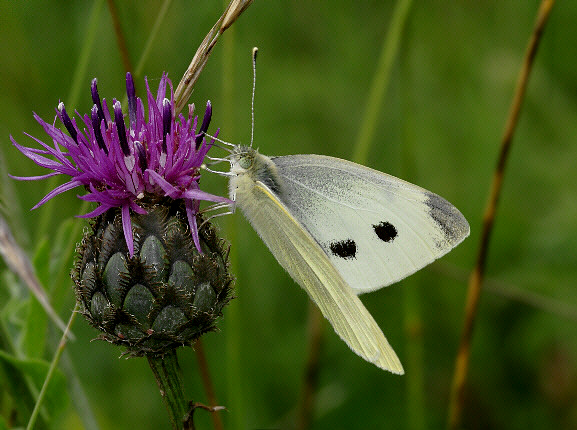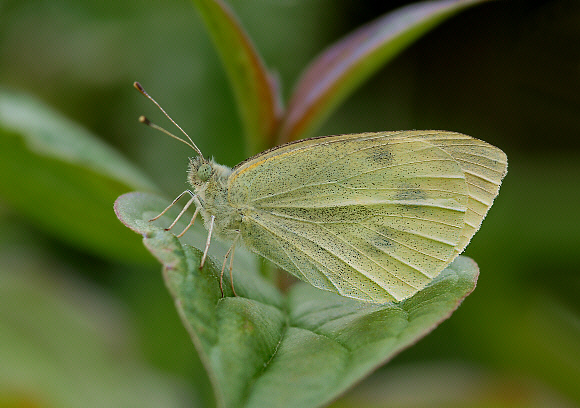
Introduction
There may be as many as 34 species of Pieris worldwide, although the status of some is uncertain. The commonest and most widespread species is rapae, which was originally restricted to Europe and temperate Asia but has been introduced by man to North America, Africa, s.e. Asia, Australia and New Zealand.
The genus can be divided into 2 groups – the ‘Large’ Whites brassicae, cheiranthi, deota & tadjika; and the smaller species including rapae, mannii, napi and melete which have more rounded fore-wings. Some taxonomists place the latter group into a distinct genus Artogeia, citing characteristics including chromosome number, ovipositing behaviour and larval morphology.
The Small White is one of the most widely distributed species in the world ( the most widespread of all being the Painted Lady ). It occurs throughout Europe, in north Africa, throughout the Middle East and eastward across temperate Asia to Japan. It was introduced to Canada in 1860, and to the USA in 1866. During the 20th century it was introduced to numerous other countries including Bermuda, Australia, New Zealand and Iceland.
Habitats
This is a strongly migratory species which can be found in almost any habitat with the exception of the highest mountain peaks. However it is far commoner in the vicinity of gardens, allotments and farmland where crucifers ( cabbage, sprouts etc ) are grown.
Lifecycle
The pale yellow, skittle-shaped eggs are laid singly on the underside of the leaves of cabbages and sprouts Brassica, garden nasturtiums Tropaeolum, and less often on Sinapis or other wild crucifers. Often several eggs will be laid on the same plant, or even under the same leaf, but these are laid by different females, or by successive visits by a single female.
The dull green, slightly hairy caterpillars feed diurnally on the leaves of the foodplants. On cabbages the young larvae bury deep into the heart of the plants, inflicting serious damage to the developing leaves. When older they feed openly, nibbling a mass of irregularly shaped holes out of the leaves, but leaving the midrib and tougher veins intact. They are a serious commercial pest of cabbage crops but do less damage than the larvae of the Cabbage moth Mamestra brassicae.
The larvae are heavily predated by harvestmen and beetles, and by birds including sparrows, tits, warblers and thrushes. Also, in common with most other caterpillars they are attacked by various parasitoids, the main culprit in this case being Apanteles wasps.
The chrysalis has several colour forms, ranging from pale green to a dirty brownish white, with dark dots on the abdomen. It is attached either vertically or horizontally to fence-posts, brick walls, or the underside of shed roofs, windowsills and other sturdy materials.

Adult behaviour
Early in the day, or in overcast conditions, the butterflies bask with their wings half-open, reflecting solar energy onto the thorax and abdomen, which are covered with dark hair-like scales that assist in rapid heat absorption. In sunny conditions they usually keep their wings shut when resting or nectaring, but copulated pairs usually rest with wings partly open.

Males patrol around cabbages and other crucifers, waiting to intercept females. When the sexes meet, the male flies up and down in front of the female, enticing her to settle, and then settles beside her. He then uses his outspread wings to force the female to lean to one side, and bends his abdomen round to copulate with her. Immediately after joining, the pair fly a short distance to settle on the foliage of a nearby plant. If a male intercepts an unresponsive female, she spreads her wings and raises her abdomen as a rejection signal.
The butterflies often congregate in sheltered gardens to oviposit, or to seek nectar at cultivated flowers, particularly favouring buddleia. In the countryside they often gather to nectar at patches of hemp agrimony, marjoram, thistles, knapweeds, yellow rattle, or valerian.
They roost singly, usually on the upper surface of the leaves of bushes or herbaceous plants, even in rainy weather.
